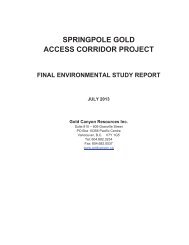Malawi NI 43-101 - December 2011 - Gold Canyon Resources Inc.
Malawi NI 43-101 - December 2011 - Gold Canyon Resources Inc.
Malawi NI 43-101 - December 2011 - Gold Canyon Resources Inc.
- No tags were found...
Create successful ePaper yourself
Turn your PDF publications into a flip-book with our unique Google optimized e-Paper software.
(b) Limitations or failure to verify dataThe soils analyzed for leachable REE are considered a reasonable test of thesmall number of previously reported results from Chambe Basin soils.(c) Opinion on adequacy of verification dataThe amount and composition of easily-leachable REE are the principal mattersthat required verification. However, obtaining a laboratory to provide the mostappropriate method for leaching proved difficult in the short time available. In theopinion of the author better leaching methods should be found before further analysesare done. The author initially attempted to persuade ALS Chemex to carry out exactlythe same procedure used by Nittetsu Mining R & D on the original Ishikawa samples,a simple leach with a 2% ammonium sulphate aqueous solution described by Chi(1988). Unfortunately, ALS declined to carry out this procedure, perhaps partlybecause of pressure of work, partly due to the small number of samples involved, andpartly because they would first have to develop quality control procedures andleachable-REE standard samples. Other commercial laboratories would likely have asimilar response and, while it may have been possible to persuade a university orother laboratory to carry out these leaches these likely lack accreditation or even thesort of quality assurance provided by commercial labs and required for <strong>43</strong>-<strong>101</strong> reports.Because the ammonium sulphate leach noted above was not available twodifferent leach procedures (see Item 11 (b)) offered by ALS Chemex were chosen asalternatives, both very weak leaches that selectively strip loosely bound ions. Theleach method ME-MS04 (ammonium acetate) gave results comparable to theammonium sulphate leaches at the Nittetsu and Mitsui laboratories, but method ME-MS23 (ammonium chloride) appears to extract much lower percentages of REE(Table 13).Summary From the author’s brief August visit the following were verified.1 Chambe basin is a large bowl in a subcircular syenite intrusion that contains thicksoils. The soils appear to be derived from the underlying syenite, which crops out inmany places and also occurs as residual boulders in the soils.2 Soils consist of fragments of feldspar and ferromagnesian minerals frombreakdown of the syenite, mixed with kaolinite from weathering of the rock. Soil






